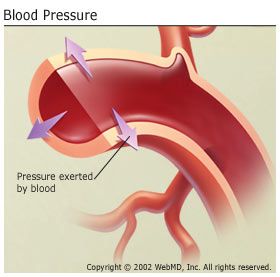Blood pressure
Blood is carried from the heart to all parts of your body in vessels called arteries. Blood pressure is the force of the blood pushing against the walls of the arteries. Each time the heart beats (about 60-70 times a minute at rest), it pumps out blood into the arteries. Your blood pressure is at its highest when the heart beats, pumping the blood. This is called systolic pressure. When the heart is at rest, between beats, your blood pressure falls. This is the diastolic pressure.
Blood pressure is always given as these two numbers, the systolic and diastolic pressures. Both are important. Usually they are written one above or before the other, such as 120/80 mmHg. The top number is the systolic and the bottom the diastolic. When the two measurements are written down, the systolic pressure is the first or top number, and the diastolic pressure is the second or bottom number (for example, 120/80). If your blood pressure is 120/80, you say that it is "120 over 80."
Blood pressure changes during the day. It is lowest as you sleep and rises when you get up. It also can rise when you are excited, nervous, or active.
Still, for most of your waking hours, your blood pressure stays pretty much the same when you are sitting or standing still. That level should be lower than 120/80. When the level stays high, 140/90 or higher, you have high blood pressure. With high blood pressure, the heart works harder, your arteries take a beating, and your chances
Blood pressure is always given as these two numbers, the systolic and diastolic pressures. Both are important. Usually they are written one above or before the other, such as 120/80 mmHg. The top number is the systolic and the bottom the diastolic. When the two measurements are written down, the systolic pressure is the first or top number, and the diastolic pressure is the second or bottom number (for example, 120/80). If your blood pressure is 120/80, you say that it is "120 over 80."
Blood pressure changes during the day. It is lowest as you sleep and rises when you get up. It also can rise when you are excited, nervous, or active.
Still, for most of your waking hours, your blood pressure stays pretty much the same when you are sitting or standing still. That level should be lower than 120/80. When the level stays high, 140/90 or higher, you have high blood pressure. With high blood pressure, the heart works harder, your arteries take a beating, and your chances
of a stroke, heart attack, and kidney problems are greater
www.lifeclinic.com







